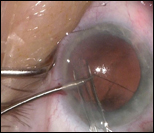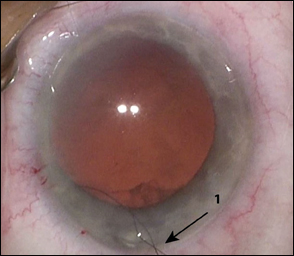Suture-guided technique may eliminate intraoperative risk during CTR insertion
The technique allows a capsular tension ring to be inserted while mitigating the risk of capsule entanglement or iatrogenic zonular dialysis.
Using a suture-guided technique to insert a capsular tension ring into the capsular bag may lessen the potential for intraoperative complications such as capsule entanglement or iatrogenic zonular dialysis, according to a study.
A capsular tension ring (CTR) supports areas of zonular weakness by creating tension within the capsular bag, but complications may arise if torque is created between the CTR and capsular bag. As a result, this could cause an extension of zonular dialysis or creation of an iatrogenic dialysis, the study said.
Timothy F. Page, MD, described the benefits of a suture-guided technique for CTR insertion in comparison to several other techniques used to alleviate complications.
“The benefit is that it helps to mitigate an iatrogenic zonular dialysis, to lessen the chances of the leading eyelet from becoming entangled in redundant capsular folds, and it provides another level of safety to prevent problems during insertion of the CTR,” he told Ocular Surgery News.
Surgical technique

Images: Page TF





The capsular bag is filled with an ophthalmic viscosurgical device, which is important to minimize the risk for capsule entanglement with the leading eyelet of the CTR, the study said.
Next, a 10-0 suture is passed through the leading eyelet of the CTR before it is deployed into the capsular bag. Gentle traction is applied on the suture with microforceps to help guide the leading eyelet centrally in order to decrease the risk of subsequent capsular bag displacement.
Microforceps can be used by pulling the leading eyelet of the CTR away from areas of torque if capsular bag displacement is suspected, which results in less stress on the zonular fibers, or if the dialysis appears to extend during CTR insertion, which provides control within the eye to guide insertion.
After the CTR has been inserted, the suture remains in the leading eyelet as it comes to position in the fornix of the capsular bag. It can be cut at the incision and pulled on one end for removal from the leading eyelet of the CTR.
“So what this does is it gives you a second tool inside of the eye to put some tension on the leading edge of the CTR to help guide it past areas where it could become entangled or helps mitigate the torsional force of the CTR as it expands out of the inserter,” Page said. “It allows you to pull gently on the suture that is going through the leading eyelet of the CTR so that you don’t create too much torque on the capsular bag and the CTR won’t get entangled.”
Suture-guided benefits
Page has performed the suture-guided technique in 12 cases and has had no complications thus far. He is also developing “a device that would help with insertion so that it wouldn’t have to be a two-handed technique.”
Compared with standard CTR insertion and the “fishtail on a line” technique, the suture-guided technique allows the surgeon to use microforceps to dial in the CTR, the study said. Therefore, those familiar with the use of microsurgical instruments should have a shorter learning curve, Page said.
“I think that a surgeon who is familiar with using microsurgical instruments in the eye will probably adapt to it quite quickly,” he said. “These are instruments that fit through very small incisions and have micro-action, such as microforceps. So there might be a bit of a learning curve in learning that.”
Because the technique requires an inserter and a second microsurgical instrument in the anterior chamber to guide the suture in the leading eyelet of the CTR, Page also thinks that familiarity with microinstruments could affect the learning curve.
“Also, you would have to be able to insert the CTR in a one-handed fashion, so either manually or with a plunger-style inserter. You would not be able to use it with a threaded inserter because it does require use of one hand to guide the suture and one hand to insert the CTR,” he said. – by Kristie L. Kahl
- Reference:
- Page TF. J Cataract Refract Surg. 2015;doi:10.1016/j.jrcs.2015.08.004.
- For more information:
- Timothy F. Page, MD, can be reached at Oakland Ophthalmic Surgery, 800 S. Adams Road, Suite 201, Birmingham, MI 48009; email: tpagemd@yahoo.com.
Disclosure: Page reports no relevant financial disclosures.
